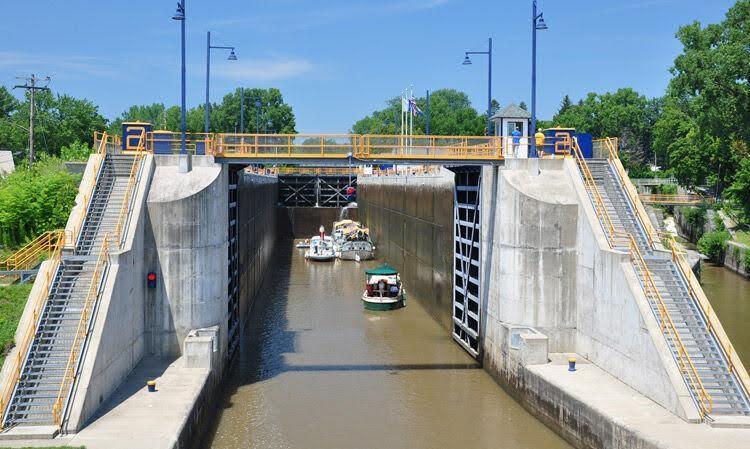Are you looking to expand your boating horizons? Don’t let a navigational lock keep you from exploring rivers, canals, and other waterways.
Locks – and some of the larger vessels that go through them – can be intimidating. But don’t worry. Armed with some knowledge – and some practice – you’ll feel confident enough to navigate through locks in no time. Read on for our tips on how to “lock through” like a pro.
Locks 101

Trent Severn Waterway photo source: parks.canada.ca
Navigational locks connect different bodies of water, like rivers and lakes. They’re basically the elevators that allow boats to get around waterfalls and other perilous places with different water levels. For instance, to get from Lake Ontario to Lake Erie, vessels need to bypass Niagara Falls and the 99.5 meter (326.5 foot) height difference between those two Great Lakes. And the eight locks along Canada’s Welland Canal make that passage possible.

Big Chute Marine Railway photo source: parks.canada.ca
Locks vary in sophistication. And that can make locking an adventure. The Songo Lock in Maine, for instance, is still manually operated by park service employees and energetic volunteers. At the other end of the spectrum is the Big Chute Marine Railway that uses an ingenious system of railroad track and carriages to move boats over a precarious rocky “chute” on the Trent Severn waterway.

Erie Canal photo source: Erie Canalway National Heritage Corridor
Understanding the key components of a lock is essential for successful navigation. These parts include:
- Lock Chamber: This is the main body of the lock where vessels are moored while the water level rises or lowers. It’s the equivalent of the elevator car – except some lock chambers accommodate 300-meter (1,000-foot) ocean freighters. The lock chamber is enclosed by the upper and lower gates.
- Gates: The large doors that you enter and exit through when locking. They keep the water in or out of the lock chamber.
- Cill (or Sill): The ledge inside the lock chamber located at the upper gate. It’s mission critical to keep an eye on the cill as your boat moves upwards in the lock to avoid potential damage.
- Bollards and Rings: These are provided for mooring your boat inside the lock chamber. They are situated on the lock walls.
Preparation is no Accident
Just like any other boating procedure, navigating a lock begins long before you’re anywhere near the gates. Here’s a handy checklist to ensure your boat is ready to lock through:
- Confirm the lock is operating. Some lock systems close during winter and flood season. And others go offline periodically for maintenance and repairs.
- Plan ahead and anticipate delays. Locking through can happen in as few as 15 minutes in some places, and it can take hours in others. If you have dinner plans or a marina reservation on the other side of a lock, call the lock operator to check on traffic and plan accordingly.
- Bring at least one crew member to handle lines while you’re maneuvering in the lock.
- Fuel up in case there is traffic at the lock – or if you’re going to pass through a series of locks.
- Bring plenty of fenders – enough to protect both sides of your boat along with the bow and stern. Some recreational boaters tie clusters of 2-3 fenders together to make a “fender board” to keep the hull from touching the sides of the lock chamber.
- Make sure the boat’s engine and any thrusters are in good working condition.
- Bring at least one boat pole, a sharp knife, and extra rope.
- Keep your VHF radio switched on and tuned to the correct channel for lock operations.
Familiarize yourself with the specific lock procedures and signals. Even though most locks use standard practices, radio frequencies, and traffic signal patterns, there are occasional nuances.
For instance, the use of red, amber, and green signals is intuitive at most locks. But the signals have a slightly different meaning at the Chicago Harbor Lock. In Chicago, the amber signal indicates only commercial signals may enter the lock while recreational boaters must wait for the green signal before entering.
PRO TIP: Check the Wavve Boating App or other online resources to confirm any locks on your float plan are operating. And, if needed, the Wavve app can help you find an alternate route. Scroll down for more information on Wavve Boating or click here to download the app now.
Safety First
Before entering the lock, make sure to address some key safety items:
- Ensure all passengers are wearing personal floatation devices (PFDs). Some locks will not permit boats to enter unless everyone is wearing a life jacket.
- Never tie off a line while you’re in the lock. Instead, always wrap lines around cleats, cables, and bollards – and designate a crew member to hold the line, adjusting as the water rises or lowers.
- Crew members should be equipped with a sharp knife in case a line gets snagged.
- Deploy fenders on the lock side. Be prepared to raft up against another recreational vessel.
- Keep a boat pole on the lock side to grab lines and push away from lock walls and other vessels. Never use hands or feet to push away from other vessels or lock structures.
- Make sure pets and small children are in the cabin or positioned far away from the rails.
- If you aren’t prepared to enter the lock, it’s okay to tie up at the Blue Line in front of the lock gates and wait until you’re ready.
Lock Etiquette: Don’t Be “That Boater”
Locks function safely and efficiently when all boaters follow common protocols:
- The lock operator or “lockmaster” is in charge and directs traffic through the lock chamber.
- Never enter a lock without permission. Before approaching the lock gates, contact the lock operator and make sure you are in the queue. Signal methods vary by location and may include any combination of the following:
-
- Radio – most locks in Canada and the U.S. use VHF channel 14
- Telephone
- Pull rope at the lock wall
- Horn signal
- Loudspeaker
- Signal traffic lights: red, amber, and green
- Vessels enter and exit locks according to a strict order of priority:
- Military and emergency vessels
- Government vessels
- Commercial vessels
- Recreational watercraft
- Locking is very similar to docking in a marina. After the gates open and the lock staff signals for your boat to enter:
- Enter slowly enough that you aren’t creating a wake; Alternate between neutral and drive – and use your thrusters to maneuver into your designated position.
- Keep a boat pole handy to grab mooring lines and to push away from walls and other vessels; Lock tenders may help guide your boat to a parking spot.
- Watch for a floating bollard or a vertical cable to secure your boat, remembering to NEVER TIE OFF A LINE while you’re in the lock. Instead, wrap lines around cleats, cables, and bollards and adjust the line as the water level rises or lowers.
- In a crowded lock, you may need to raft-up to another vessel.
- Turn on the engine blower(s).
- Enjoy the ride.
- The lockmaster will signal when the gates are preparing to open. Once they’re open, restart your engine(s) and wait to be signaled. Remember: boats follow a first-in / first-out sequence when entering and departing locks. Unless the lock operator provides different directions, wait your turn to leave. And depart patiently.
- Do not create a wake until you have left the lock and the mooring area in front of the gates.
Common Locking Mistakes
Despite the best preparations and intentions, locking mistakes can happen. Here are a few common ones to watch out for:
- Not preparing your boat adequately before approaching the lock.
- Ignoring instructions or signals from the lock staff.
- Exiting the lock too quickly or without proper clearance.
For Those About to Lock – We Salute You!
Navigating a lock might seem daunting initially. But with patience and practice, it can become second nature. Remember the golden rule of boating – safety first! Always heed the instructions from the lock staff, keep your boat well-prepared, and maintain a steady, controlled speed.
Next time you approach a lock, remember the tips from this comprehensive guide. We promise it will make your lock navigation a lot smoother, safer, and more enjoyable. Happy boating!
Ready To Hit The Water?
If you’re interested in hitting the water, but aren’t sure exactly where to go (or how to get there) check out the Wavve Boating App. You can review the top rated destination near you and easily connect with your friends out on the water. It’s an all-in-one tool that’s sure to have everything you need…no matter which boating adventure you’re on.
Wavve Boating is available on the Apple App Store and Google Play Store. To discover more, visit us in the app.







